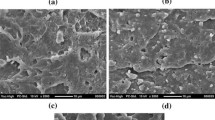Abstract
Three-dimensional (3D) printed poly (ethylene glycol) diacrylate (PEGDA) objects have been reinforced with 1%, 3% and 5% silica (Si02) nanoparticles. Rheological characterizations were conducted for each formulation and 3D-printed using a stereolithographic apparatus (SLA) 3D printer. The tensile and compressive properties of the as-printed nanocomposites were investigated and compared with unreinforced samples. Additionally, the mechanical properties of the objects before and after swelling the samples in deionized water were compared with as-printed ones. Adding Si02 increased the tensile and compressive strengths of the 3D-printed PEGDA. The tensile and compressive strengths of swollen PEGDA/Si02 nanocomposite specimens were generally higher than the unswollen specimens.







Similar content being viewed by others
References
J. Dizon, A.H. Espera, Q. Chen, and R. Advincula: Mechanical characterization of 3D-printed polymers. Additive Manuf. 20, 44 (2018).
M. Attaran: The rise of 3-D printing: the advantages of additive manufacturing over traditional manufacturing. Bus. Horizons 60, 677 (2017).
Z. Weng, Y. Zhou, W. Lin, T. Senthil, and L. Wu: Structure-property relationship of nano enhanced stereolithography resin for desktop SLA 3D printer. Composites: Part A 88, 234 (2016).
J. Crivello and E. Reichmanis: Photopolymer materials and processes for advanced technologies. Chem. Mater. 26, 533 (2014).
A. Kannurpatti, J. Anseth, and C. Bowman: A study of the evolution of mechanical properties and structural heterogeneity of polymer networks formed by photopolymerizations of multifunctional (meth)acrylates. Polymer 39, 2507 (1998).
H. Gojzewski, M. Sadej, E. Andrzejewska, and M. Kokowska: Nanoscale Young’s modulus and surface morphology in photocurable polyacry-late/nanosilica composites. Eur. Polym. J. 88, 205 (2017).
M. Sadej-Bajerlain, H. Gojzewski, and E. Andrzejewska: Monomer/modified nanosilica systems: photopolymerization kinetics and composite characterization. Polymer 52, 1495 (2011).
P. Palmero: Structural ceramic nanocomposites: a review of properties and powders’ synthesis methods. Nanomaterials 5, 656 (2015).
S. Beun, T. Glorieux, J. Devaux, J. Vreven, and G. Leloup: Characterization of nanofilled compared to universal and microfilled composites. Dental Mater. 23, 51 (2007).
J. Manapat, J. Mangadlao, B. Tiu, G. Tritchler, and R. Advincula: High-strength stereolithographic 3D printed nanocomposites: graphene oxide metastability. ACS Appl. Mater. Interfaces 9, 10085 (2017).
A. de Leon, Q. Chen, N. Palaganas, J. Palaganas, J. Manapat, and R. Advincula: High performance polymer nanocomposites for additive manufacturing applications. React. Funct. Polym. 103, 141 (2016).
H. Liu and J. Mo: Study on nanosilica reinforced stereolithography resin. J. Reinf. Plast. Compos. 29, 909 (2010).
H. Gong, M. Beauchamp, S. Perry, A. Woolley, and G. Nordin: Optical approach to resin formulation for 3D printed microfluidics. RSC Adv. 5, 106621 (2015).
C. Rogers, J. Pagaduan, G. Nordin, and A. Woolley: Single-monomer formulation of polymerized polyethylene glycol diacrylate as a nonadsorptive material for microfluidics. Anal. Chem. 83, 6418 (2011).
P. Kim, H. Jeong, A. Khademhosseini, and K. Suh: Fabrication of non-biofouling polyethylene glycol micro- and nanochannels by ultraviolet-assisted irreversible sealing. Lab. Chip. 6, 1432 (2006).
M. Cuchiara, A. Allen, T. Chen, J. Miller, and J. West: Multilayer microflui-dic PEGDA hydrogels. Biomaterials 31, 5491 (2010).
A. Sacca, R. Pedicini, A. Carbone, and E. Passalacqua: Comparative investigation on nano-sized SiO2 as a Filler for Proton Exchange Membranes (PEM) Fuel Cells. ECS Trans. 11, 1553 (2007).
Cabot Corporation, http://twinstar-corp.com/wp-content/uploads/2012/05/cabot-fmo/FMNTCA001%20EH5.pdf (accessed August 2017).
T. Chartier, A. Badev, Y. Abouliatima, P. Lebaudy, and L. Lecamp: Stereolithography process: influence of the rheology of silica suspensions and of the medium on polymerization kinetics - Cured depth and width. J. Eur. Ceramic Soc. 32, 1625 (2012).
C. Hinczewski, S. Corbel, and T. Chartier: Ceramic suspensions suitable for stereolithography. J. Eur. Ceramic Soc. 18, 583 (1998).
M. Wozniak, T. de Hazan, T. Graule, and D. Kata: Rheology of UV curable colloidal silica dispersions for rapid prototyping applications. J. Eur. Ceramic Soc. 31, 2221 (2011).
M. Wozniak, T. Graule, Y. de Hazan, D. Kata, and J. Lis: Highly loaded UV curable nanosilica dispersions for rapid prototyping applications. J. Eur. Ceramic Soc. 29, 2259 (2009).
R. Ottenbrite, P. Kinam, and T. Okano: Biomedical Applications of Hydrogels Handbook. Springer-Verlag, New York (2010).
B. Tighe: The role of permeability and related properties in the design of synthetic hydrogels for biomedical applications. Br. Polym. J. 18, 8 (1986).
R. Wong, M. Ashton, and K. Dodou: Effect of crosslinking agent concentration on the properties of unmedicated hydrogels. Pharmaceutics, 1 305 (2015).
Intertek, http://www.intertek.com/polymers/testlopedia/tga-astm-e1131/ (accessed September 2017).
Sigma Aldrich, http://www.sigmaaldrich.com/catalog/product/aldrich/437441?lang=en®ion=US (accessed August 2017).
J. Cornelissen and H. Waterman: The viscosity temperature relationship of liquids. Chem. Eng. Sci. 4, 238 (1955).
F. Horkay and M. Zrinyi: Studies on mechanical and swelling behavior of polymer networks on the basis of the scaling concept. 7. Effect of deformation on the swelling equilibrium concentration of gels. Macromolecules 21, 3260 (1998).
Y. Oka, S. Sakohara, T. Gotoh, and T. Iizawa: Measurements of mechanical properties on a swollen hydrogel by a tension test method. Polym. J. 36, 59 (2004).
ACKNOWLEDGMENTS
This work is supported by the Department of Science and Technology — Philippine Council for Industry, Energy, and Emerging Technology Research and Development (DOST-PCIEERD) and PETRO Case and the Honeywell-KCNSC Polymer 3D printing consortium (Dr. Jamie Messman and Dr. Dan Bowen).
Author information
Authors and Affiliations
Corresponding author
Supplementary materials
Supplementary materials
The supplementary material for this article can be found at https://doi.org/10.1557/mrc.2018.188
Rights and permissions
About this article
Cite this article
Dizon, J.R.C., Chen, Q., Valino, A.D. et al. Thermo-mechanical and swelling properties of three-dimensional-printed poly (ethylene glycol) diacrylate/silica nanocomposites. MRS Communications 9, 209–217 (2019). https://doi.org/10.1557/mrc.2018.188
Received:
Accepted:
Published:
Issue Date:
DOI: https://doi.org/10.1557/mrc.2018.188




